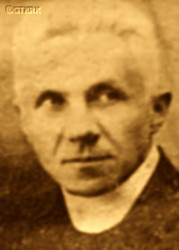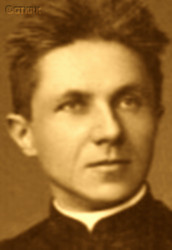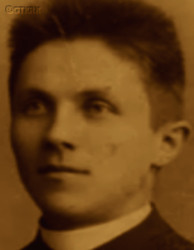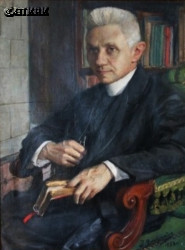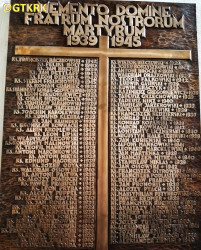Roman Catholic
St Sigismund parish
05-507 Słomczyn
85 Wiślana Str.
Konstancin deanery
Warsaw archdiocese, Poland
full list:
displayClick to display full list

searchClick to search full list by categories
wyświetlKliknij by wyświetlić pełną listę po polsku

szukajKliknij by przeszukać listę wg kategorii po polsku

Martyrology of the clergy — Poland
XX century (1914 – 1989)
personal data
surname
ŁĘGOWSKI
forename(s)
Vladislav Leonard (pl. Władysław Leonard)
function
diocesan priest
creed
Latin (Roman Catholic) Church RCmore on
en.wikipedia.org
[access: 2014.09.21]
diocese / province
Culm (Chełmno) diocesemore on
pl.wikipedia.org
[access: 2012.11.23]
RC Military Ordinariate of Polandmore on
en.wikipedia.org
[access: 2014.12.20]
academic distinctions
Doctor of Philosophy
honorary titles
„Polonia Restituta” Cross — 5th Class, Knight'smore on
en.wikipedia.org
[access: 2019.04.16]
(08.11.1930)
date and place
of death
02.01.1941

KL Stutthofconcentration camp
today: Sztutowo, Sztutowo gm., Nowy Dwór Gdański pov., Pomerania voiv., Poland
more on
en.wikipedia.org
[access: 2022.01.09]
alt. dates and places
of death
GdańskWrzeszcz borough
today: Gdańsk city pov., Pomerania voiv., Poland
more on
en.wikipedia.org
[access: 2022.01.28]
details of death
In the years 1895‐1899 — during German occupation (Prussian partition of Poland) — while studying at the Germ. Königliches Katholisches Gymnasium (Eng. Royal Catholic Gymnasium) in Chełmno, member of the gymnasium chapter of the Polish clandestine student self–education Pomeranian Philomaths organization.
In 1909‐1912 as a teacher in Lyceum for Girls in Kościerzyna conducted secret Polish language, history and literature lectures.
After the abdication of the German Emperor William II Hohenzollern on 09.11.1918, after the armistice between the Allies and Germany signed on 11.11.1918 in the HQ wagon in Compiègne, the HQ of French Marshal Ferdinand Foch — which de facto meant the end of World War I; after transfer of the supreme authority over the Polish army to Brigadier Joseph Piłsudski as its commander‐in‐chief — which de facto meant the rebirth of the Polish state — member of County People's Council in Wąbrzeźno (1918‐1920), established in response to the self‐disclosure and founding on 11.11.1918 in Poznań, in the Prussian/German part of partitioned Poland, of the Polish People's Council opting for Poland. Member of the School Commission preparing the takeover of education by the Polish authorities. Organizer of weapons supplies to the local People's Guard, an unpaid citizen militia subordinate to the Supreme People's Council.
Prob. then arrested by the Germ. Grenzschutz Ost (a German paramilitary organization militarily opposing the separation of Polish lands from Germany). Maltreated. Held in prison in Gdańsk for several weeks and released.
After German invasion of Poland on 01.09.1939 (Russians invaded Poland 17 days later) and start of the World War II set up a field hospital in his rectory treating Polish soldiers (801th field hospital of 4th Infantry Division of Polish Army). Ministered as a chaplain and nurse. With the hospital and Polish troops moved south to Kutno. After start of German occupation returned to his Wielkie Radowiska parish.
Immediately afterwards arrested on 24.10.1939 by the Germans.
Jailed in VSH Dembowalonka camp in Dębowa Łąka.
Released on 25.11.1939 after intervention of his German parishioners.
Evicted from his rectory taken over by German gendarmes.
On 05.02.1940 additionally nominated administrator of Lipnica — without a priest because of arrest of Fr Stanislav Jarzębski — and Zieleń filial churches (in Golub parish).
On 09.09.1940 arrested by the Germans again.
For three weeks held in Grudziądz prison.
From there transported to KL Stutthof concentration camp.
There forced to do a slave work.
Interrogated numerous times.
On 01.01.1941 beaten up unconscious and carried bloodied to the camps' barrack.
There perished next day in the morning.
alt. details of death
According to some sources arrested by the Germans on 28.11.1939 already.
According to other sources on 01.01.1941 beaten up unconscious in Gdańsk–Wrzeszczgaol.
Perished next day — prob. in Gdańsk–Wrzeszcz hospital.
According to yet another sources brought to Gdańsk–Wrzeszcz hospital earlier, on 08.12.1940.
prisoner camp's numbers
10103Click to display source page (KL StutthofClick to display the description)
cause of death
murder
perpetrators
Germans
sites and events
KL StutthofClick to display the description, Gdańsk (prison)Click to display the description, VSH GraudenzClick to display the description, VSH DembowalonkaClick to display the description, «Intelligenzaktion»Click to display the description, Reichsgau Danzig‐WestpreußenClick to display the description, Ribbentrop‐MolotovClick to display the description, Pius XI's encyclicalsClick to display the description, Pomeranian PhilomathsClick to display the description
date and place
of birth
06.11.1877

Zieleńtoday: Wąbrzeźno gm., Wąbrzeźno pov., Kuyavia‐Pomerania voiv., Poland
more on
en.wikipedia.org
[access: 2021.09.02]
parents
ŁĘGOWSKI James
🞲 01.07.1842, Zieleńtoday: Wąbrzeźno gm., Wąbrzeźno pov., Kuyavia‐Pomerania voiv., Poland
more on
en.wikipedia.org
[access: 2021.09.02] — 🕆 22.10.1904, ?

WILEMSKA Justine
🞲 06.12.1849, Szwarcenowotoday: Biskupiec gm., Nowe Miasto Lubawskie pov., Warmia‐Masuria voiv., Poland
more on
en.wikipedia.org
[access: 2021.09.02] — 🕆 ?, ?
presbyter (holy orders)
ordination
22.03.1903

Pelplintoday: Pelplin gm., Tczew pov., Pomerania voiv., Poland
more on
en.wikipedia.org
[access: 2021.05.06]
positions held
1912 – 09.09.1940
parish priest — Wielkie Radowiskatoday: Dębowa Łąka gm., Wąbrzeźno pov., Kuyavia‐Pomerania voiv., Poland
more on
en.wikipedia.org
[access: 2021.09.02] ⋄ St James the Apostle RC parish ⋄ Golubtoday: district of Golub‐Dobrzyń, Golub‐Dobrzyń gm., Golub‐Dobrzyń pov., Kuyavia‐Pomerania voiv., Poland
more on
en.wikipedia.org
[access: 2021.09.02] RC deanery
05.02.1940 – 09.09.1940
administrator — Lipnicatoday: Szamotuły gm., Szamotuły pov., Greater Poland voiv., Poland
more on
en.wikipedia.org
[access: 2021.12.18] ⋄ St Michael the Archangel RC parish ⋄ Golubtoday: district of Golub‐Dobrzyń, Golub‐Dobrzyń gm., Golub‐Dobrzyń pov., Kuyavia‐Pomerania voiv., Poland
more on
en.wikipedia.org
[access: 2021.09.02] RC deanery — acting („ad interim”)
05.02.1940 – 09.09.1940
curatus/rector/expositus — Zieleńtoday: Wąbrzeźno gm., Wąbrzeźno pov., Kuyavia‐Pomerania voiv., Poland
more on
en.wikipedia.org
[access: 2021.09.02] ⋄ St Peter and St Paul the Apostles RC church ⋄ Golubtoday: district of Golub‐Dobrzyń, Golub‐Dobrzyń gm., Golub‐Dobrzyń pov., Kuyavia‐Pomerania voiv., Poland
more on
en.wikipedia.org
[access: 2021.09.02], St Catherine of Alexandria the Virgin and Martyr RC parish ⋄ Golubtoday: district of Golub‐Dobrzyń, Golub‐Dobrzyń gm., Golub‐Dobrzyń pov., Kuyavia‐Pomerania voiv., Poland
more on
en.wikipedia.org
[access: 2021.09.02] RC deanery — acting („ad interim”)
till 1940
censor of religious books (Lat. censores librorum) — Pelplintoday: Pelplin gm., Tczew pov., Pomerania voiv., Poland
more on
en.wikipedia.org
[access: 2021.05.06] ⋄ Diocesan Curia
chaplain — The Pomeranian Banner, Polish Scouting Association ZHP — in the rank of scoutmaster
c. 1921 – 1923
director — Toruńtoday: Toruń city pov., Kuyavia‐Pomerania voiv., Poland
more on
en.wikipedia.org
[access: 2021.06.20] ⋄ Municipal gymnasium for Women
1909 – 1912
teacher — Kościerzynatoday: Kościerzyna urban gm., Kościerzyna pov., Pomerania voiv., Poland
more on
en.wikipedia.org
[access: 2021.08.20] ⋄ Higher Lyceum for Girls (part of Our Lady of the Angels Institute) ⋄ Holy Trinity RC parish ⋄ Mirachowotoday: Kartuzy gm., Kartuzy pov., Pomerania voiv., Poland
more on
en.wikipedia.org
[access: 2020.11.27] RC deanery — teacher of mathematics, biology, physics and chemistry
vicar — Fordontoday: district of Bydgoszcz, Bydgoszcz city pov., Kuyavia‐Pomerania voiv., Poland
more on
en.wikipedia.org
[access: 2021.09.02] ⋄ St Nicholas the Bishop and Confessor RC parish ⋄ Fordontoday: district of Bydgoszcz, Bydgoszcz city pov., Kuyavia‐Pomerania voiv., Poland
more on
en.wikipedia.org
[access: 2021.09.02] RC deanery
vicar — Toruńtoday: Toruń city pov., Kuyavia‐Pomerania voiv., Poland
more on
en.wikipedia.org
[access: 2021.06.20] ⋄ St James the Apostle RC parish ⋄ Toruńtoday: Toruń city pov., Kuyavia‐Pomerania voiv., Poland
more on
en.wikipedia.org
[access: 2021.06.20] RC deanery
till c. 1908
PhD student — Würzburgtoday: Würzburg urban dist., Lower Franconia reg., Bavaria state, Germany
more on
en.wikipedia.org
[access: 2022.08.05] ⋄ philosophy, Department of Theology, Julius–Maximilian University [i.e. Germ. Julius–Maximilians–Universität (Eng. Julius–Maximilian University) (from 1918) / Germ. Königlich Bayerische Julius–Maximilians–Universität (Eng. Royal Bavarian Julius–Maximilian University)] — PhD thesis Germ. „Beiträge zur experimentellen Aesthetik” (Eng. „Contributions to experimental aesthetics”), ed. 1908, LIpsk
1904 – 1907
PhD student — Leipzigtoday: Leipzig urban dist., Saxony state, Germany
more on
en.wikipedia.org
[access: 2022.07.16] ⋄ philosophy, Germ. Universität Leipzig (Eng. University of Leipzig) — also: chaplain to Polish emigrants and migrants
till 1904
vicar — Radoszkitoday: Bartniczka gm., Brodnica pov., Kuyavia‐Pomerania voiv., Poland
more on
en.wikipedia.org
[access: 2021.10.09] ⋄ St Lawrence the Martyr and St Nicholas the Bishop and Confessor RC parish ⋄ Lidzbarktoday: Lidzbark gm., Działdowo pov., Warmia‐Masuria voiv., Poland
more on
en.wikipedia.org
[access: 2022.01.28] RC deanery
from 1903
vicar — Koronowotoday: Koronowo gm., Bydgoszcz pov., Kuyavia‐Pomerania voiv., Poland
more on
en.wikipedia.org
[access: 2021.12.19] ⋄ Assumption of the Blessed Virgin Mary RC parish ⋄ Fordontoday: district of Bydgoszcz, Bydgoszcz city pov., Kuyavia‐Pomerania voiv., Poland
more on
en.wikipedia.org
[access: 2021.09.02] RC deanery
1902 – 1903
student — Pelplintoday: Pelplin gm., Tczew pov., Pomerania voiv., Poland
more on
en.wikipedia.org
[access: 2021.05.06] ⋄ philosophy and theology, Theological Seminary
1900 – 1902
student — Münstertoday: Münster urban dist., Münster reg., North Rhine‐Westphalia state, Germany
more on
en.wikipedia.org
[access: 2021.07.18] ⋄ philosophy and theology, Wilhelm University of Westphalia [i.e. Wilhelm University of Westphalia (from 1907) / Royal University of Theology and Philosophy (1902–1907) / Royal Theological and Philosophical Academy] (1843–1902)
1899 – 1900
student — Pelplintoday: Pelplin gm., Tczew pov., Pomerania voiv., Poland
more on
en.wikipedia.org
[access: 2021.05.06] ⋄ philosophy and theology, Theological Seminary
till c. 1899
pupil — Chełmnotoday: Chełmno urban gm., Chełmno pov., Kuyavia‐Pomerania voiv., Poland
more on
en.wikipedia.org
[access: 2021.07.25] ⋄ Germ. Königliche Katholische Gymnasium (Eng. Royal Catholic Gymnasium) — studies completed with the maturity diploma (i.e. matura)
1890 – 1895
pupil — Pelplintoday: Pelplin gm., Tczew pov., Pomerania voiv., Poland
more on
en.wikipedia.org
[access: 2021.05.06] ⋄ „Collegium Marianum” progymnasium
anthropologist
1908 – 1939
membership — Toruńtoday: Toruń city pov., Kuyavia‐Pomerania voiv., Poland
more on
en.wikipedia.org
[access: 2021.06.20] ⋄ scientific society
1908 – 1939
membership — Poznańtoday: Poznań city pov., Greater Poland voiv., Poland
more on
en.wikipedia.org
[access: 2021.07.18] ⋄ Friends of Sciences Society
others related
in death
JARZĘBSKIClick to display biography Stanislav Romualdo, BOLTClick to display biography Felix, BORKOWSKIClick to display biography Paul, BRUDNICKIClick to display biography Alexander Casimir, BRZEZIŃSKIClick to display biography Paul John, CZAPLEWSKIClick to display biography John Bruno, DOMACHOWSKIClick to display biography Joseph, FARULEWSKIClick to display biography Thaddeus, GÓRECKIClick to display biography Marian, GRABOWSKI–WIDŁAKClick to display biography Casimir, GUMPERTClick to display biography Steven Edward, KALINOWSKIClick to display biography Anthony, KARBAUMClick to display biography Ernest, KOMOROWSKIClick to display biography Bronislav Boleslav, KREFFTClick to display biography Constantine Francis, KUBICKIClick to display biography Telesphorus, LESIŃSKIClick to display biography Alexander, LESIŃSKIClick to display biography John, MALINOWSKIClick to display biography Thaddeus, MAŁKOWSKIClick to display biography Julius, MAŃKOWSKIClick to display biography Alphonse, MATERNICKIClick to display biography Vladislav, MAZELLAClick to display biography John, NIEMIRClick to display biography Joseph, OSSOWSKIClick to display biography Valerian, POŁOMSKIClick to display biography Leo Louis John, RODZIŃSKAClick to display biography Stanislava (Sr Mary Julia), ROGACZEWSKIClick to display biography Francis Xavier, RÓŻYCKIClick to display biography Mieczyslav Bogumil, RYGLEWICZClick to display biography John, SĄDECKIClick to display biography Bernard, SARNOWSKIClick to display biography Joseph, SCHULZClick to display biography Alphonse Vaclav, SEPEŁOWSKIClick to display biography Vaclav, SMOLEŃSKIClick to display biography Bronislav, SROKAClick to display biography Leo Florian, SZWEDOWSKIClick to display biography Ignatius Mieczyslav, SZYMAŃSKIClick to display biography John Joseph, SZYMAŃSKIClick to display biography Vladislav, WIECKIClick to display biography Bernard Anthony, WILMOWSKIClick to display biography John, BĄCZKOWSKIClick to display biography Francis, BREJSKIClick to display biography John Casimir, CHARSZEWSKIClick to display biography Paulinus Ignatius, DEKOWSKIClick to display biography Francis, DERKACZEWSKAClick to display biography Stanislava (Sr Raphaella of the Holy Face), GALIKOWSKIClick to display biography Roman John, GNILKAClick to display biography Pauline (Sr Junilla), JONEKClick to display biography Martha (Sr Dygna), KOWNACKIClick to display biography Bronislav, KOWNACKIClick to display biography Martin Stanislav, KUCZAClick to display biography Francesca (Sr Gorgonya), LICZNERSKIClick to display biography Constantine John, RUCIŃSKIClick to display biography Francis, WILEMSKIClick to display biography Joseph Louis, ZAREMBAClick to display biography Felix Joseph Hubert, ZIEMIAŁKOWSKAClick to display biography Hedwig (Sr Dominica of the Sacred Wounds of Jesus), BATKOClick to display biography Alexander, BIELEŃClick to display biography Anthony, BOJUŁKAClick to display biography Bronislav Francis, BORZYSZKOWSKIClick to display biography Joseph, BROCKIClick to display biography Anthony, BUSZTAClick to display biography Anthony (Fr Simon), CZUBEKClick to display biography Joseph, FLACZYŃSKIClick to display biography Francis, GASIŃSKIClick to display biography Louis, GOŁĘBIEWSKIClick to display biography Joseph Lawrence, GRABOWSKIClick to display biography Sigismund, GREGORKIEWICZClick to display biography Leo, HINZClick to display biography Thaddeus, KACZOROWSKIClick to display biography Michael, KĘDZIERSKIClick to display biography Francis, KLUNDERClick to display biography John, KOPAŃSKIClick to display biography Conrad, ŁUBIEŃSKIClick to display biography John Boleslav, MAKOWSKIClick to display biography Paul (Fr Bruno), MALINOWSKIClick to display biography Constantine Peter, MARTENKAClick to display biography John, MATEUSZCZYKClick to display biography Theodore, MIĘTKIClick to display biography Anthony, NAGÓRSKIClick to display biography Edmund Marian, NIKLASClick to display biography Stanislav, NOWAKClick to display biography Stanislav Zeno, ODYAClick to display biography Joseph Florian, ODYAClick to display biography Lucyn Joseph, OLSZEWSKIClick to display biography Edward, OSSOWSKIClick to display biography John Anthony, OSTROWSKIClick to display biography Francis Xavier, PARTYKAClick to display biography Boleslav, PASTWAClick to display biography Anthony, PRABUCKIClick to display biography Boleslav Rock, PRYBAClick to display biography Leo Simon, PTACHClick to display biography Louis Paul, RADTKEClick to display biography Steven Boleslav, ROGALSKIClick to display biography John, SADOWSKIClick to display biography Anastasius, SOBISZClick to display biography Anthony, SOWIŃSKIClick to display biography Emil Bronislav, STELLAClick to display biography Joseph, TUSZYŃSKIClick to display biography Joseph, WILAMOWSKIClick to display biography Alexander, WILCZEWSKIClick to display biography Francis Joseph, WOLSKIClick to display biography Vaclav, ZIELIŃSKIClick to display biography Paul Nicholas, ŻUCHOWSKIClick to display biography Vaclav
sites and events
descriptions
KL Stutthof: In German Germ. Konzentrationslager (Eng. concentration camp) KL Stutthof (then in Eastern Prussian belonging to Germany, today: Sztutowo village) concentration camp, that Germans started to build on 02.09.1939, a day after German invasion of Poland and start of the World War II, Germans held c. 110,000‐127,000 prisoners from 28 countries, including 49,000 women and children. C. 65,000 victims were murdered and exterminated. In the period of 25.01‐27.04.1945 in the face of approaching Russian army Germans evacuated the camp. When on 09.05.1945 Russians soldiers entered the camp only 100 prisoners were still there. In an initial period (1939‐1940) Polish Catholic priests from Pomerania were held captive there before being transported to KL Dachau concentration camp. Some of them were murdered in KL Stutthof or vicinity (for instance in Stegna forest). Also later some Catholic priests were held in KL Stutthof. (more on: stutthof.orgClick to attempt to display webpage
[access: 2018.11.18], en.wikipedia.orgClick to attempt to display webpage
[access: 2013.07.06])
Gdańsk (prison): During World War II German prison where many Kashubian activists and resistance fighters were held. Death sentences — through guillotine beheading — were also carried out there. (more on: pl.wikipedia.orgClick to attempt to display webpage
[access: 2015.09.30])
VSH Graudenz: As part of «Intelligenzaktion» — physical extermination of Polish intelligentsia from Pomerania — Germans initially in 09.1939 held Poles captive in investigative prison in Grudziądz. After it became too small the genocidal German paramilitary organization Volksdeutscher Selbstschutz — the decision to create Selbstschutz in the Polish lands occupied by German troops was made in Berlin on 08‐10.09.1939 at a conference headed by Reichsführer‐SS Heinrich Himmler (the formal order bears the date 20.09.1939), and the chaotically formed units were directly subordinated to the officers of the genocidal SS organization — organized the Germ. Volksdeutscher Selbstschutzhaft (Eng. Volksdeutscher Selbstschutz custody) VSH in the building of the so‐called Borderlands Hostel building at Chopin Str. (on 31.03.1937, before German invasion, it housed 97 boys). In this building Germans held captive 4,000 to 5,000 Poles, including c. 150 local priests and c. 100 teachers and students of the local teachers' seminary. Most of them were subsequently murdered in local forests (Księże Góry, Mniszek‐Grupa), some were taken to concentration camps and 200 boys — residents of the Borderlands Hostel — were after some time deported as slave laborers to Germany. Everything was obviously done in accordance with „German law” — there was an ad hoc Volksdeutscher Selbstschutz kangaroo court in the camp, which „issued sentences” deciding on the fate of imprisoned Poles. (more on: pl.wikipedia.orgClick to attempt to display webpage
[access: 2013.01.13])
VSH Dembowalonka: German Germ. Volksdeutscher Selbstschutzhaft (Eng. Volksdeutscher Selbstschutz custody) VSH for the clergy of Wąbrzeźno county. Established on 24‐25.09.1939, when Germans, members of the genocidal paramilitary Germ. Volksdeutscher Selbstschutz formation — the decision to create Selbstschutz in the Polish lands occupied by German troops was made in Berlin on 08‐10.09.1939 at a conference headed by Reichsführer‐SS Heinrich Himmler (the formal order bears the date 20.09.1939), and the chaotically formed units were directly subordinated to the officers of the genocidal SS organization ‐ in the Shepherd Sisters CSDP monastery–institute in Dębowa Łąka, c. 10 km from Wąbrzeźno, interned 30 Catholic priests from nearby parishes (on the same day, the Germans destroyed all roadside statues and crosses in Wąbrzeźno district). As part of the «Intelligenzaktion» operation — the extermination of the Polish intelligentsia (in Kurkocin, c. 4 km away, the Germans murdered then c. 500 Poles) — they were detained there till 06.12.1939, and then transported to another camp in Chełmno and next to KL Stutthof concentration camp. After the end of hostilities of World War II, in the years 1954‐1957, during the Russian occupation, one of the concentration and slave labor camps organized by Commie‐Nazi authorities in Russian republic prl for religious sisters and nuns during «Action X‐2». (more on: pl.wikipedia.orgClick to attempt to display webpage
[access: 2014.10.31])
«Intelligenzaktion»: German: «Intelligenzaktion» (English: „Intelligence Action”) — a German program of extermination of the Polish elite, mainly the intelligentsia and leadership layers, carried out from the beginning of the occupation in w 09.1939 to 04.1940, mainly in territories directly annexed to Germany, but also in the so‐called Germ. Generalgouvernement (Eng. General Governorate), where it was called «AB‐aktion». In the first phase, immediately after the beginning of the German occupation, during military operations carried out by the Germ. Wehrmacht (Eng. Armed Forces) and the genocidal units of the Germ. Einsatzgruppen (Eng. Operational Groups) of the Germ. Sicherheitspolizei (Eng. Security Police), i.e. SiPo, and Germ. Sicherheitsdienst des Reichsführers SS (Eng. Security Service of the Reichsführer SS), i.e. SD, organized by the Germ. Reichssicherheitshauptamt (Eng. Reich Main Security Office), i.e. RSHA, which followed the troops, carried out under the Germ. Unternehmen „Tannenberg” (Eng. Operation „Tannenberg”) — based on the so‐called Germ. Sonderfahndungsliste (Eng. Special Wanted Lists), i.e. proscription lists of Poles considered particularly dangerous to the Third Reich, prepared by the Zentralstelle II/P (Polen) unit of the German RSHA. Later, implemented by the German civilian occupation authorities and the genocidal unit of the Germ. Volksdeutscher Selbstschutz (Eng. Ethnic Germans Self‐Defense), whose members were Germ. Volksdeutsche (Eng. Ethnic Germans), i.e. representatives of the German minority in Poland. According to various sources, these lists, at the beginning of 09.1939, could have contained the details of 61,000—88,000 „dangerous” Poles — although these figures cannot be confirmed. In total, during this genocide, c. 50,000 teachers, Catholic priests, representatives of the landed gentry, freelancers, social and political activists, and retired military personnel were systematically and methodically murdered. Another 50,000 were sent to concentration camps, where only a negligible percentage survived. (more on: en.wikipedia.orgClick to attempt to display webpage
[access: 2014.10.04])
Reichsgau Danzig‐Westpreußen: After the Polish defeat in the 09.1939 campaign, which was the result of the Ribbentrop‐Molotov Pact and constituted the first stage of World War II, and the beginning of German occupation in part of Poland (in the other, eastern part of Poland, the Russian occupation began), the Germans divided the occupied Polish territory into five main regions (and a few smaller). The largest one was transformed into Germ. Generalgouvernement (Eng. General Governorate), intended exclusively for Poles and Jews and constituting part of the so‐called Germ. Großdeutschland (Eng. Greater Germany). Two were added to existing German provinces. From two other separate new provinces were created. Vistula Pomerania region was one of them, incorporated into Germany on 08.10.1939, by decree of the German leader Adolf Hitler (formally came into force on 26.10.1939), and on 02.11.1939 transformed into the Germ. Reichsgau Danzig‐Westpreußen (Eng. Reich District of Gdańsk‐West Prussia) province, in which the law of the German state was to apply. The main axis of the policy of the new province, the territory of which the Germans recognized as the Germ. „Ursprünglich Deutsche” (Eng. „natively German”), despite the fact that 85% of its inhabitants were Poles, was Germ. „Entpolonisierung” (Eng. „Depolonisation”), i.e. forced Germanization. C. 60,000 Poles were murdered in 1939‐1940, as part of the Germ. „Intelligenzaktion”, i.e. extermination of Polish intelligentsia and ruling classes, in c. 432 places of mass executions — including c. 220 Polish Catholic priests. The same number were sent to German concentration camps, from where few returned (over 300 priests were arrested, of whom c. 130 died in concentration camps). C. 124,000‐170,000 were displaced, including c. 90,000 to the Germ. Generalgouvernement. Poles were forced en masse to sign the German nationality list, the Germ. Deutsche Volksliste DVL. Polish children could only learn in German. It was forbidden to use the Polish language during Catholic Holy Masses and during confession. Polish landed estates were confiscated..To further reduce the number of the Polish population, Poles were sent to forced labor deep inside Germany. The remaining Poles were treated as low‐skilled labor, isolated from the Germans and strictly controlled — legally, three or three of them could only meet together, even in their own apartments. Many were conscripted into the German Wehrmacht army. After the end of hostilities of World War II, the overseer of this province, the Germ. Reichsstatthalter (Eng. Reich Governor) and the Germ. Gauleiter (Eng. district head) of the German National Socialist Party, Albert Maria Forster, was executed. (more on: en.wikipedia.orgClick to attempt to display webpage
[access: 2024.06.24])
Ribbentrop‐Molotov: Genocidal Russian‐German alliance pact between Russian leader Joseph Stalin and German leader Adolf Hitler signed on 23.08.1939 in Moscow by respective foreign ministers, Mr. Vyacheslav Molotov for Russia and Joachim von Ribbentrop for Germany. The pact sanctioned and was the direct cause of joint Russian and German invasion of Poland and the outbreak of the World War II in 09.1939. In a political sense, the pact was an attempt to restore the status quo ante before 1914, with one exception, namely the „commercial” exchange of the so‐called „Kingdom of Poland”, which in 1914 was part of the Russian Empire, fore Eastern Galicia (today's western Ukraine), in 1914 belonging to the Austro‐Hungarian Empire. Galicia, including Lviv, was to be taken over by the Russians, the „Kingdom of Poland” — under the name of the General Governorate — Germany. The resultant „war was one of the greatest calamities and dramas of humanity in history, for two atheistic and anti‐Christian ideologies — national and international socialism — rejected God and His fifth Decalogue commandment: Thou shall not kill!” (Abp Stanislav Gądecki, 01.09.2019). The decisions taken — backed up by the betrayal of the formal allies of Poland, France and Germany, which on 12.09.1939, at a joint conference in Abbeville, decided not to provide aid to attacked Poland and not to take military action against Germany (a clear breach of treaty obligations with Poland) — were on 28.09.1939 slightly altered and made more precise when a treaty on „German‐Russian boundaries and friendship” was agreed by the same murderous signatories. One of its findings was establishment of spheres of influence in Central and Eastern Europe and in consequence IV partition of Poland. In one of its secret annexes agreed, that: „the Signatories will not tolerate on its respective territories any Polish propaganda that affects the territory of the other Side. On their respective territories they will suppress all such propaganda and inform each other of the measures taken to accomplish it”. The agreements resulted in a series of meeting between two genocidal organization representing both sides — German Gestapo and Russian NKVD when coordination of efforts to exterminate Polish intelligentsia and Polish leading classes (in Germany called «Intelligenzaktion», in Russia took the form of Katyń massacres) where discussed. Resulted in deaths of hundreds of thousands of Polish intelligentsia, including thousands of priests presented here, and tens of millions of ordinary people,. The results of this Russian‐German pact lasted till 1989 and are still in evidence even today. (more on: en.wikipedia.orgClick to attempt to display webpage
[access: 2015.09.30])
Pius XI's encyclicals: Facing the creation of two totalitarian systems in Europe, which seemed to compete with each other, though there were more similarities than contradictions between them, Pope Pius XI issued in 03.1937 (within 5 days) two encyclicals. In the „Mit brennender Sorge” (Eng. „With Burning Concern”) published on 14.03.1938, condemned the national socialism prevailing in Germany. The Pope wrote: „Whoever, following the old Germanic‐pre‐Christian beliefs, puts various impersonal fate in the place of a personal God, denies the wisdom of God and Providence […], whoever exalts earthly values: race or nation, or state, or state system, representatives of state power or other fundamental values of human society, […] and makes them the highest standard of all values, including religious ones, and idolizes them, this one […] is far from true faith in God and from a worldview corresponding to such faith”. On 19.03.1937, published „Divini Redemptoris” (Eng. „Divine Redeemer”), in which criticized Russian communism, dialectical materialism and the class struggle theory. The Pope wrote: „Communism deprives man of freedom, and therefore the spiritual basis of all life norms. It deprives the human person of all his dignity and any moral support with which he could resist the onslaught of blind passions […] This is the new gospel that Bolshevik and godless communism preaches as a message of salvation and redemption of humanity”… Pius XI demanded that the established human law be subjected to the natural law of God , recommended the implementation of the ideal of a Christian state and society, and called on Catholics to resist. Two years later, National Socialist Germany and Communist Russia came together and started World War II. (more on: www.vatican.vaClick to attempt to display webpage
[access: 2023.05.28], www.vatican.vaClick to attempt to display webpage
[access: 2023.05.28])
Pomeranian Philomaths: Secret societies of Polish youth, aiming at self‐education, patriotic in form and content, functioning 1830‐1920, mainly in secondary schools — gymnasia — in Pomerania around Vistula river (Gdańsk Pomerania and Chełmno county), in Prussian‐occupied Polish territories (one of the partitions of Poland). On 08.01.1901 Germans conducted a series of interrogations of students at Chełmno, Brodnica and Toruń gymnasiums. On 09‐12.09.1901 the first of court trials of Polish students from those gymnasiums and students of Theological Seminary in Pelplin was held in Toruń. 1 person was sentenced to 3 months in prison, 1 to 2 months, 3 to 6 weeks, 7 to 3 weeks, 2 to 2 weeks, 19 to a week, 2 to 1 day, 10 were reprimanded. 15 were cleared. More definitive penalties were relegations from the schools with so‐called wolf’s ticket, forbidding sentenced students to continue secondary and higher studies in Prussia (Germany). Among those penalized were a few future Catholic priests — those were able to continue their education for the Chełmno diocese bishop, Bp August Rosentreter, refused to relegate students from Theological Seminary. (more on: pl.wikipedia.orgClick to attempt to display webpage
[access: 2018.11.18])
sources
personal:
www.zapiskihistoryczne.plClick to attempt to display webpage
[access: 2017.01.21], www.niedziela.diecezja.torun.plClick to attempt to display webpage
[access: 2013.01.13], kpbc.umk.plClick to attempt to display webpage
[access: 2018.11.18], www.youtube.comClick to attempt to display webpage
[access: 2013.12.04], www.geni.comClick to attempt to display webpage
[access: 2025.11.05]
bibliographical:
„Biographical dictionary of priests of the Chełmno diocese ordained in the years 1821‐1920”, Henry Mross, Pelplin, 1995
original images:
www.niedziela.diecezja.torun.plClick to attempt to display webpage
[access: 2013.01.13], www.myheritage.comClick to attempt to display webpage
[access: 2015.09.30], www.youtube.comClick to attempt to display webpage
[access: 2014.10.31], nieobecni.com.plClick to attempt to display webpage
[access: 2018.11.18], www.youtube.comClick to attempt to display webpage
[access: 2014.10.31], www.youtube.comClick to attempt to display webpage
[access: 2014.10.31], gdansk.ipn.gov.plClick to attempt to display webpage
[access: 2020.10.02]
LETTER to CUSTODIAN/ADMINISTRATOR
If you have an Email client on your communicator/computer — such as Mozilla Thunderbird, Windows Mail or Microsoft Outlook, described at WikipediaPatrz:
en.wikipedia.org, among others — try the link below, please:
LETTER to CUSTODIAN/ADMINISTRATORClick and try to call your own Email client
If however you do not run such a client or the above link is not active please send an email to the Custodian/Administrator using your account — in your customary email/correspondence engine — at the following address:

giving the following as the subject:
MARTYROLOGY: ŁĘGOWSKI Vladislav Leonard
To return to the biography press below:
 Click to return to biography
Click to return to biography








